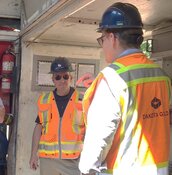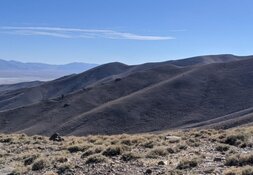The Mining Report: You're a survivor. Mining investors want to know what they will need to survive 2015. What's your message?
Paul Renken: Always know how much you can afford to risk in any particular situation, but it's probably the time to be bold simply because the sector has done worse than anyone has expected over the last year or so. That is essentially forcing out the weak players.
TMR: Weak players?
PR: Weak players are those looking for a short-term turn in a particular stock in order to make a short-term gain. There just hasn't been a significant move upward in virtually any of the commodities. In fact, just the opposite has happened. We've had a significant selloff.
TMR: How should investors play this market? Are you seeking specific situations across all commodities?
"Nemaska Lithium Inc.'s Whabouchi is a deposit that's simple to mine and process."
PR: We're being quite selective. For instance, the difficulties in the iron ore market are widely known—iron ore just dipped below US$70/ton—but there are some specific circumstances that warrant a closer look, simply because they were hit early and had the opportunity to fall farther than their peers. The firm is not particularly bullish on iron ore going forward but we expect that the price will be somewhat higher next year, so there is going to be a modest recovery.
TMR: Are other commodities showing favorable support levels in this market?
PR: We think that there is going to be continued strength in diamonds and colored stones. That has been a good market this year for equity investors as auction prices have strengthened. The growth market is in Asia for polished stones, both colored and white stones, diamonds and colored gemstones like rubies and sapphires. And that seems to be continuing.
Another commodity that we like here is lithium. The confirmation that Tesla Motors Inc. (TSLA:NASDAQ) will build the "Gigafactory" in Nevada definitely strengthened the outlook for lithium. And other automobile manufacturers are attempting to make electric and hybrid vehicles both popular and commercially profitable, too.
TMR: Gemstones and lithium. Any others?
PR: We also see some good support on a longer-term basis for tungsten, simply because the market hasn't been flooded with too much material, unlike what has happened in iron ore and oil.
TMR: Please outline your investment thesis for junior mining companies in this market.
PR: We want to see sizzle in the story. It could be a deeply discounted cash flow position that the company is either acquiring or that has been inappropriately discounted. Some investors are also looking for a dividend yield that's relatively secure even though the commodity that the company produces has witnessed some weakness. Another angle is a significant discovery or an acquisition that was made via exploration drilling through a deal. These kinds of sizzle will help move these stories because there are too many junior companies where the project is going to stay where it's at without something to sell it. You also have to have confidence that the story will come to fruition rather than just a blind punt on the gambling table.
TMR: What are some telltale signs that something is a legitimate story?
PR: One thing is a clear timeline that is achievable for what the company intends to accomplish. That could be how long it will take to get a permit or how much money it will take to finance a portion of the exploration or development. Those two things let us know that management has a good understanding of the project as it develops. Another one is three-dimensional evidence that there is continuity of high-grade mineralization. An additional good sign is a simple and clear path to how a potential investor would make money because complications essentially make stories much more difficult to believe.
TMR: How many mistakes are you willing to forgive before you sell?
PR: If I were an investor in a project, I would have a clear vision as to how much I was prepared to tolerate. I could probably tolerate only one or two errors. But if I owned shares and it becomes clear that the reason I initially invested is not going to happen right away, I would be prepared to exit a position after the first mistake.
TMR: Are you more willing to discount delays in a market where money is difficult to find?
PR: The short answer is no. The reason is that most investors are not solely invested in natural resources. They have more than enough other opportunities to risk their capital. That's part of the problem with the sector. Equity performance has been so poor across natural resources for so long that the money has exited to less risky places.
TMR: Let's start with gold. Gold has bounced up from its bottom of US$1,140/ounce (US$1,140/oz) in early November to as high as a little above $1,230/oz in early December. Please give us your thoughts on gold's fundamentals and how those numbers will influence its performance in 2015?
PR: At the beginning of the year VSA Capital thought that gold would spend some significant time between US$1,100/oz and US$1,200/oz, but not below that level. We're still working on our forecast for 2015; we expect some modest improvement, but we don't see any big move to the upside—given what we see in current economic and trading activity. There is, however, a tremendous sense of concern—I wouldn't call it foreboding but there is concern—about what is going to happen when the U.S. starts to implement rising interest rates and, in particular, what will happen with the bond market because institutional money is heavily vested there.
By all measurements the bond market is significantly stretched. If everyone decides to leave bonds and head for the exit at the same time, not everybody is going to get out without significant losses. The U.S. Treasury market is so big and liquid that most of the money will go there, but some of it could go into gold and silver. Even small percentages of the bond market money moving to gold and silver would cause a significant price jump.
TMR: What are some gold-focused equities that you're following?
PR: We follow quite a few gold stocks for various reasons. I break the group into producers and explorers. I'll start with the producers.
Randgold Resources Ltd. (GOLD:NASDAQ; RRS:LSE) is a producing stock that is considered a bellwether for gold. It only produces gold, so it's a clean measurement as to the equity movement with gold prices. It's widely followed.
Another firm is Pan African Resources Plc (PAF:AIM; PAN:JSE). It's a South African gold producer and that's the only country in which it operates. It also has modest production of platinum group metals from a tailings retreatment project. Pan African is a dividend-paying stock, which is unique for AIM-listed mining stocks.
Caledonia Mining Corp. (CAL:TSX; CMCL:AIM; CALVF:OTCQX) is a small-scale, Canada and London-listed stock with a CA$37.5 million (£20.9M) market cap. It operates an underground gold mine in Zimbabwe and also pays a high-yield dividend. If you want to be in the micro-cap space and watch the performance of a relatively low-grade underground operation, Caledonia Mining is one to keep an eye on.
In the U.S. we closely watch Scorpio Gold Corp. (SGN:TSX.V). It's a CA$22.5M market-cap company that operates an open-pit gold mine in western Nevada. That company has done quite well in making relatively low-grade, open-pit gold production profitable.
Finally, Metanor Resources Inc. (MTO:TSX.V), a Canadian underground producer in Quebec. We follow that one because it is a restart of an old mine that was in production at Bachelor Lake a number of years ago. It seems to be making good progress.
TMR: Metanor is exploring in and around the former Coniagas mine. What do you make of its efforts?
PR: It's early days around the old Coniagas mine. Bachelor Lake was the first focus of the operation. Metanor had to make sure that Bachelor Lake reached commercial cash flow in order to afford to take a closer look at other past-producers like Coniagas. Metals prices are not making the story as good as it otherwise could or would have been during 2014, but we'll just have to see what the drill bit ends up finding at Coniagas.
TMR: Among the gold explorers?
PR: Just a few names there. Kalimantan Gold Corp. (KLG:TSX.V) is one of our clients. It has a tiny market cap, just £2.5M. It just acquired a second copper porphyry project in Indonesia with a 2 million ounce (2 Moz) gold resource. The company's original copper project is on the island of Kalimantan. Both copper projects demonstrate 0.6% average copper grade in compliant resources from surface. It's the kind of story that has the sizzle that I talked about, which significantly improves the appearance and the solidity of the underlying portfolio of the junior explorer.
Another company is Orbis Gold Ltd. (OBS:ASX), which does all of its exploration activity in Burkina Faso. It has two potential open-pit properties with a more than 1 Moz resource at good grade. It's proving to have the kinds of grade and tonnage that could lead to a production opportunity at relatively low cash costs. It's definitely a stock that shareholders have liked over the past year.
Mwana Africa Plc (MWA:AIM) is profitably producing nickel at the 74.7%-owned Bindura mine in Zimbabwe, but the real upside in this stock in my view is in gold. It co-owns with the state mining firm SOKIMO the 2.97 Moz Zani-Kodo gold project in the Democratic Republic of the Congo (DRC). The deposit is similar to the 18 Moz Kibali gold mine that AngloGold Ashanti Ltd. (AU:NYSE; ANG:JSE; AGG:ASX; AGD:LSE) and Randgold Resources put into production in the DRC. Zani-Kodo has similar geology to Kibali, yet the Mwana story is not being valued for these ounces. It keeps drilling more and more gold intercepts with just about every hole on that project. We're looking forward to more good news from that company.
TMR: Will silver rebound in 2015?
PR: Silver has been anything but steady over the last couple of months, with a rather drafty fall from US$21/oz all the way down to US$14/oz. It is now around US$17/oz. The real disappointment is that worldwide industrial manufacturing activity is not stronger because silver is largely an industrial metal. The silver-gold ratio is into the 70s—something we haven't seen for years. Silver should outperform gold if manufacturing activity improves because the uptake on ounces produced would be far better. I expect silver to be more volatile than gold as it moves into the $19–21/oz range again next year. That would be a 20% gain.
TMR: What are some silver-focused equities VSA is tracking?
PR: We regularly follow Fresnillo Plc (FRES:LSE). It's one of the stocks that institutions tend to have in their portfolios, particularly Mexican institutions. By the same token, it's also a stock with consistently falling grades in its overall production profile. We want to see how that affects its margins.
Another stock that we follow quite closely is Endeavour Silver Corp. (EDR:TSX; EXK:NYSE; EJD:FSE). It has a $280M market cap but has witnessed declining margins in 2014 as a result of the declining silver price. It is well-run company, though, so we think those margins will improve.
Also, Fortuna Silver Mines Inc. (FSM:NYSE; FVI:TSX; FVI:BVL; F4S:FSE) has outperformed its production guidance in the two recent quarters. We think investors should take a look at it.
TMR: What's the sizzle with Fortuna?
PR: It caught my attention because it exceeded its production guidance on its operations, as well as its forecast margins between cash costs and all-in costs. We want to see companies that are improving their economic fundamentals on a production basis and don't have to worry about making those improvements by selling assets.
TMR: When we talked with you in the summer, we discussed tungsten and its market fundamentals. You said earlier that you see modest long-term growth in tungsten prices.
PR: Earlier this year the World Trade Organization ruled against China's export tariffs on molybdenum and tungsten, and we are uncertain how the Chinese will react. Some commodities like tungsten are highly dependent on one particular country's production or export activity. In this case, it's China. China imposed tariffs because it wants to make sure that it has as much tungsten and molybdenum as necessary to support domestic manufacturing. We doubt China would flood the market with tungsten as it did in the 1970s because the market dynamics are very different. The current ammonium paratungstate (APT) price is around US$350/metric tonne unit ($350/Mtu), which is fair. We think that the tungsten price overall is going to stay steady, if not rise in tandem with inflation in 2015.
TMR: Can most of the suppliers make money at $350/Mtu?
PR: Yes, most of the established suppliers can make money at that price.
TMR: What are some tungsten-focused equities that you're following?
PR: We tend to follow the explorers as opposed to the producers because our clientele is seeking the greater level of upside offered by a discovery.
Northcliff Resources Ltd. (NCF:TSX) is one that we follow closely. The CA$19M market-cap company is in the final stages of getting financing for the big Sisson tungsten-molybdenum open-pit operation in New Brunswick, Canada. Larger companies like to see this kind of project because it has scale. It's also in a low-risk, stable country, so the bankers have some assurance that if debt financing is arranged they will be paid appropriately.
Another company that we follow is U.K.-listed Thor Mining Plc (THR:LSE; THR:ASX). It's a tiny, $3M-market-cap company with a feasibility-stage tungsten-molybdenum project in eastern Australia. It should be profitable but the market doesn't give it much attention because it's a small deposit. So Thor is attempting to broaden its project portfolio by stepping into some new projects in western Nevada, which have received some traction with institutional investors.
Finally, we follow Blackheath Resources Inc. (BHR:TSX.V), which is exploring an area that once produced most of Europe's tungsten. It has a market cap of CA$6.5M and the management team is experienced. A couple of years ago Blackheath management sold off a profitable tungsten mining operation in Portugal and rewarded shareholders. Now essentially the same team is back in the same country in an attempt to do what they did successfully before—develop a tungsten resource into production at good margins and then sell the company.
TMR: Is a takeover likely?
PR: It has five or six different projects, all of which were in production during World War II or thereafter but were forced out of the market when the Chinese flooded it in the late 1970s. These are brownfield projects where Blackheath controls dominant pieces of ground in these past-producing districts. It could sell some or all of those assets.
TMR: And, finally, let's talk about lithium. Should investors buy into the hype surrounding the lithium necessary for the growing market for lithium ion batteries?
PR: There is an awful lot of hype and the hype has gotten ahead of what is actually happening. We recently published a lithium piece that determined that the economies of scale would finally develop in the electric vehicle market when at least 0.5–1M vehicles were produced per annum. Tesla is building its Gigafactory in Nevada to produce enough batteries for 0.5M vehicles, so it is definitely trying to produce enough batteries for the commercial electric vehicle market to take off. The Chinese have been locking up lithium deposits in order to be sure that if the market does reach critical mass, it will be the Chinese automakers that have secure lithium supplies for these batteries.
Sociedad Química y Minera de Chile S.A. (SQM:NYSE; SQM-B:SSX; SQM-A:SSX) is the dominant firm in the lithium brine space. It has a US$6.6B market cap and is producing lithium in Chile, as well as potash and borax from the brines in western South America.
An earlier-stage company that is coming along is Nemaska Lithium Inc. (NMX:TSX.V; NMKEF:OTCQX). It has a CA$31.8M market cap and is arranging financing for a pilot production plant along the St. Lawrence River that will process the lithium concentrate it produces from the Whabouchi mine in central Quebec. It has been successful in the last two fund raises in gaining additional money even though the company is not yet in production. That means there is confidence that the story will ultimately come to fruition.
TMR: The story at Nemaska seems to be grade and tonnage. How does it compare with its peers?
PR: It is a spodumene bearing pegmatite with consistent grade across its deposit. It is outcropping and easy to define in 3-D for volume and mining purposes. The geologist in me says that it's the kind of deposit that is commercially exploitable. It's a deposit that's simple to mine and process. That is the most important thing when it comes to commercial viability.
TMR: Are you following other lithium stories?
PR: A company that's trying to displace Sociedad Quimica y Minera in the lithium brine space is an Australia-listed stock called Orocobre Ltd. (ORL:TSX; ORE:ASX); some institutional investors are paying attention to it.
TMR: Is that realistic?
PR: It is a realistic goal. The Salar de Olaroz lithium deposit in Argentina is the same kind of brine that Sociedad Quimica y Minera is producing from. It will have similar capital costs, as well as scale of production. Investors in the story are looking forward to Orocobre creating competition at the upper end of the market for lithium offtake.
Another thing to watch in the lithium space is the other key component in a lithium ion battery—graphite, which is used in greater quantities by volume in these batteries than lithium. The graphite story is somewhat overhyped but the safer investments in the graphite space are deposits with a high coarse-flake component in their ore. The coarse flake, which is the shape of the graphite, is used to make the anodes of the batteries. The higher the coarse-flake component, the better the deposit. The other thing is if the company is already in production, then it has access to the relatively limited number of graphite traders around the world. That's a considerable advantage, particularly among the Western companies because most of the graphite suppliers are Chinese.
TMR: Are you following some graphite companies?
PR: Yes. One is producing now out of Madagascar on a small scale, StratMin Global Resources Plc (STGR:AIM). It has a £7M market cap.
The other name that we follow closely is Talga Resources Ltd. (TLG:ASX), which has an A$33.5M market cap. It has a very high-grade deposit with the right coarse-flake component, at least from testing done so far. But because the deposit is in Sweden, Talga will have special consideration as it finances development and construction, as well as offtake opportunities with European Union-based end users.
TMR: What's one thing we should watch for in 2015?
PR: You can be quite certain that commodity prices are going to be more volatile than they have been this year, particularly if we start seeing changes in U.S. interest rates, because institutional money will look for places to allocate money. We're talking about billions and billions of dollars moving from one asset class into another.
TMR: Thank you for your insights, Paul.
 Paul Renken has a broad range of experience in various aspects of the mining and minerals business. He began his career as a geologist for Canadian junior resource companies in the Western United States. Owning a stake in a private consulting firm as vice president of exploration, Renken searched for various base metals, precious metals and industrial minerals. In the U.K., he worked in the equity market media outlets of Digitallook and Hemscott before joining VSA as mining analyst in 2006.
Paul Renken has a broad range of experience in various aspects of the mining and minerals business. He began his career as a geologist for Canadian junior resource companies in the Western United States. Owning a stake in a private consulting firm as vice president of exploration, Renken searched for various base metals, precious metals and industrial minerals. In the U.K., he worked in the equity market media outlets of Digitallook and Hemscott before joining VSA as mining analyst in 2006.
Read what other experts are saying about:
Want to read more Mining Report articles like this? Sign up for our free e-newsletter, and you'll learn when new articles have been published. To see recent interviews with industry analysts and commentators, visit The Mining Report home page.
DISCLOSURE:
1) Brian Sylvester conducted this interview for Streetwise Reports LLC, publisher of The Gold Report, The Energy Report, The Life Sciences Report and The Mining Report, and provides services to Streetwise Reports as an independent contractor. He owns, or his family owns, shares of the following companies mentioned in this interview: None.
2) The following companies mentioned in the interview are sponsors of Streetwise Reports: Fortuna Silver Mines Inc. and Nemaska Lithium Inc. The companies mentioned in this interview were not involved in any aspect of the interview preparation or post-interview editing so the expert could speak independently about the sector. Streetwise Reports does not accept stock in exchange for its services.
3) Paul Renken: I own, or my family owns, shares of the following companies mentioned in this interview: AngloGold Ashanti Ltd. I personally am, or my family is, paid by the following companies mentioned in this interview: None. My company has a financial relationship, or had in the past 12 months, with the following companies mentioned in this interview: Thor Mining Plc, Kalimantan Gold Corp., Nemaska Lithium Inc., Blackheath Resources Inc., Northcliff Resources Ltd. I was not paid by Streetwise Reports for participating in this interview. Comments and opinions expressed are my own comments and opinions. I determined and had final say over which companies would be included in the interview based on my research, understanding of the sector and interview theme. I had the opportunity to review the interview for accuracy as of the date of the interview and am responsible for the content of the interview.
4) Interviews are edited for clarity. Streetwise Reports does not make editorial comments or change experts' statements without their consent.
5) The interview does not constitute investment advice. Each reader is encouraged to consult with his or her individual financial professional and any action a reader takes as a result of information presented here is his or her own responsibility. By opening this page, each reader accepts and agrees to Streetwise Reports' terms of use and full legal disclaimer.
6) From time to time, Streetwise Reports LLC and its directors, officers, employees or members of their families, as well as persons interviewed for articles and interviews on the site, may have a long or short position in securities mentioned. Directors, officers, employees or members of their families are prohibited from making purchases and/or sales of those securities in the open market or otherwise during the up-to-four-week interval from the time of the interview until after it publishes.









































